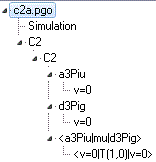
This shows an example of an electronic spectrum.
The constants are taken from G. M. Lloyd and P. Ewart,
J Chem. Phys. 110, 385 (1999). The line
positions agree with the calculated line positions from the paper
to about 0.0001 cm
-1. A small adjustment was required
to the contants - the difference between
pD+2
qD
between the two states is taken to be -9.42 rather than -0.942 as
given in Table II. (The value given in Table II is not the value
quoted by Prasad and Bernath as quoted in the footnotes to the
table.) Note that
LimitSearch="True"
is required for the F1/F2/F3 quantum numbers to be calculated
correctly. See below for a larger example involving several
vibrational states.

This is a more complicated
example, including many vibrational bands. Note that the
vibrational states are all in the same manifold, though this is
not essential. The constants are taken from A. Tanabashi, T.
Hirao, T. Amano and P. F. Bernath,
Astrophys. J.
SuppSer.
169, 472 (2007), with the
transition moments calculated from the Einstein
A
coefficnets given in J. S. A. Brooke, P. F. Bernath, T. W.
Schmidt, and G. B. Bacskay,
J Quant. Spect. Rad. Trans,
124,
11 (2013). The calculated line positions agree with the line
positions given by Tanabashi et al for clear, unperturbed lines
with an average error of 0.03 cm
-1. There are some
known local perturbations which are not included in this model.
Note that this was updated in Feb 2017; the previous version had
several estimated constants.
 This shows an example of an electronic spectrum.
The constants are taken from G. M. Lloyd and P. Ewart, J Chem. Phys. 110, 385 (1999). The line
positions agree with the calculated line positions from the paper
to about 0.0001 cm-1. A small adjustment was required
to the contants - the difference between pD+2qD
between the two states is taken to be -9.42 rather than -0.942 as
given in Table II. (The value given in Table II is not the value
quoted by Prasad and Bernath as quoted in the footnotes to the
table.) Note that LimitSearch="True"
is required for the F1/F2/F3 quantum numbers to be calculated
correctly. See below for a larger example involving several
vibrational states.
This shows an example of an electronic spectrum.
The constants are taken from G. M. Lloyd and P. Ewart, J Chem. Phys. 110, 385 (1999). The line
positions agree with the calculated line positions from the paper
to about 0.0001 cm-1. A small adjustment was required
to the contants - the difference between pD+2qD
between the two states is taken to be -9.42 rather than -0.942 as
given in Table II. (The value given in Table II is not the value
quoted by Prasad and Bernath as quoted in the footnotes to the
table.) Note that LimitSearch="True"
is required for the F1/F2/F3 quantum numbers to be calculated
correctly. See below for a larger example involving several
vibrational states. This is a more complicated
example, including many vibrational bands. Note that the
vibrational states are all in the same manifold, though this is
not essential. The constants are taken from A. Tanabashi, T.
Hirao, T. Amano and P. F. Bernath, Astrophys. J. SuppSer.169, 472 (2007), with the
transition moments calculated from the Einstein A
coefficnets given in J. S. A. Brooke, P. F. Bernath, T. W.
Schmidt, and G. B. Bacskay, J Quant. Spect. Rad. Trans, 124,
11 (2013). The calculated line positions agree with the line
positions given by Tanabashi et al for clear, unperturbed lines
with an average error of 0.03 cm-1. There are some
known local perturbations which are not included in this model.
Note that this was updated in Feb 2017; the previous version had
several estimated constants.
This is a more complicated
example, including many vibrational bands. Note that the
vibrational states are all in the same manifold, though this is
not essential. The constants are taken from A. Tanabashi, T.
Hirao, T. Amano and P. F. Bernath, Astrophys. J. SuppSer.169, 472 (2007), with the
transition moments calculated from the Einstein A
coefficnets given in J. S. A. Brooke, P. F. Bernath, T. W.
Schmidt, and G. B. Bacskay, J Quant. Spect. Rad. Trans, 124,
11 (2013). The calculated line positions agree with the line
positions given by Tanabashi et al for clear, unperturbed lines
with an average error of 0.03 cm-1. There are some
known local perturbations which are not included in this model.
Note that this was updated in Feb 2017; the previous version had
several estimated constants.